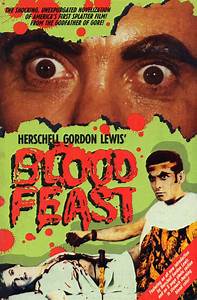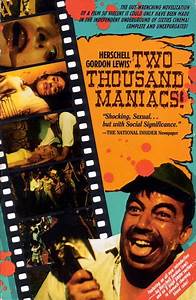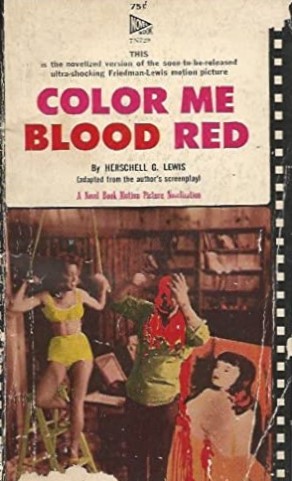The late Herschell Gordon Lewis (1926-2016) was the writer and director of the David Friedman produced 1960s-era gorefests BLOOD FEAST, TWO THOUSAND MANIACS! and COLOR ME BLOOD RED, which comprise a loose-knit trilogy. Lewis also wrote novelizations of the three films, all published in 1964 by the now-defunct paperback outfit Novel Books. In 1988 the BLOOD FEAST and TWO THOUSAND MANIACS! novelizations were republished by Fantaco Enterprises, complete with extensive black and white stills and newly penned introductions; COLOR ME BLOOD RED, alas, didn’t get the same treatment.
Lewis’ attitude toward these books was evident in his admission that “I had other projects (at the time) and never regarded them as worthy of full time attention.” Yet all three novels are enjoyable in their way, suggesting Lewis had writing talents that were never entirely developed. He’s authored quite a few books in the ensuing decades, but all are nonfiction (for the record, a fourth H.G. Lewis novel exists, an adaptation of his 1964 hillbilly comedy MOONSHINE MOUNTAIN that even Lewis himself appeared to have forgotten).
 BLOOD FEAST was the first and most outrageous of Lewis’s novelizations, suggesting that the comedy of that 1963 film wasn’t as unintentional as it might seem. H.G. Lewis admittedly went nuts with this book, which feels like a scattershot parody of BLOOD FEAST rather than a proper adaptation. The overall tone is set by the opening sentence: “It was a lousy day for Gloria…She was late for work, caught a run in her stocking, got an overdraft notice from the bank, lost her umbrella…And, at 9:14 pm, she was murdered.”
BLOOD FEAST was the first and most outrageous of Lewis’s novelizations, suggesting that the comedy of that 1963 film wasn’t as unintentional as it might seem. H.G. Lewis admittedly went nuts with this book, which feels like a scattershot parody of BLOOD FEAST rather than a proper adaptation. The overall tone is set by the opening sentence: “It was a lousy day for Gloria…She was late for work, caught a run in her stocking, got an overdraft notice from the bank, lost her umbrella…And, at 9:14 pm, she was murdered.”
The underlying narrative, concerning Fuad Ramses, a homicidal maniac who extracts peoples’ body parts for use in an Egyptian feast, is more-or-less identical to that of the film, but Lewis insists upon throwing in all sorts of extraneous elements that aren’t in the flick. Examples include a school principal busted for assigning dirty books to children, a talking cat(!), a woman who pays men to touch parts of her body, and a rather involved coda involving a second, far less inspired killer.
Lewis’ sense of humor is decidedly oft-kilter, and often downright surreal, as is evident in a passage where the cop protagonist Thornton is threatened with a gun–whose barrel he promptly bites off, inspiring the gun’s owner to exclaim “I didn’t know you liked licorice.” As for the gore so integral to the flick, it’s been reduced to almost nothing, with the film’s tongue-ripping, eyeball gouging and dismemberments all left undescribed. The effect is funny at times, but just often irritating, especially given the complete absence of anything resembling narrative continuity.
The novelization of TWO THOUSAND MANIACS! is more successful than its predecessor, as it actually follows the events of  its source film fairly closely. That film is Lewis’ personal favorite of his own work, so it makes sense that the buffoonery of the earlier novel is kept to a minimum.
its source film fairly closely. That film is Lewis’ personal favorite of his own work, so it makes sense that the buffoonery of the earlier novel is kept to a minimum.
The BRIGADOON inspired story involves six Yankees arriving in the southern town of Pleasant Valley, whose residents are having a centennial celebration and demand the Yankees partake. They reluctantly do, only to find that their part in the proceedings involves them getting killed in various elaborate ways to avenge the sins of their Civil War-era ancestors.
That latter aspect is more concretely fleshed out here than it is in the flick, with the concept of original sin introduced, and also the specter of black magic—which is crucial in explaining how it is that Pleasant Valley’s residents are still around even though they were all slaughtered 100 years earlier! Another novel component is the ending, which diverges considerably from that of the film—and is frankly a lot better, as it doesn’t meander the way the movie’s ten minute-plus conclusion did.
The adjective heavy gross-out passages are as graphic as any gorehound could possibly desire. Standout examples include the famous spiked barrel demise (“As the barrel reached the bottom of the hill, it was flinging out gouts of blood with its churning motion, and then it hit a block of stone and burst open like a ghastly, monstrous egg”) and the climactic crushing (“The rock plummeted like a giant meteor and fell directly on the screaming, struggling victim. Blood shot from her ears and mouth, as from a geyser, and her screaming ended in a grinding twisted gargle”).
Of course, this being a movie novelization—and an H.G. Lewis movie novelization at that—it contains a lot of padding, evident in Lewis’ insistence on transcribing the lyrics to the song sung throughout the book/film, “The South’s Gonna Rise Again,” at several points in the text.
 When perusing COLOR ME BLOOD RED, the last of H.G. Lewis’ novelizations, there are three pivotal things to keep in mind: 1). The film it novelizes is, as Lewis himself has conceded, not one of his better efforts, 2). It was not among the Lewis novelizations Fantaco reprinted in 1988 (and clearly there’s a reason for that), and 3). Lewis has subsequently admitted he “spent less attention” on this adaptation than he did the others. Yet even allowing for those things, COLOR ME BLOOD RED is worthwhile reading for horror buffs in a forgiving mood.
When perusing COLOR ME BLOOD RED, the last of H.G. Lewis’ novelizations, there are three pivotal things to keep in mind: 1). The film it novelizes is, as Lewis himself has conceded, not one of his better efforts, 2). It was not among the Lewis novelizations Fantaco reprinted in 1988 (and clearly there’s a reason for that), and 3). Lewis has subsequently admitted he “spent less attention” on this adaptation than he did the others. Yet even allowing for those things, COLOR ME BLOOD RED is worthwhile reading for horror buffs in a forgiving mood.
The premise, of course, is complete nonsense: Adam Sorg, a pretentious artist, is having trouble finding the right shade of red for his paintings. One day his assistant/lover Chi-Chi cuts a finger and drips blood on a canvas, which of course provides the desired hue. Adam wastes no time supplying himself with this new shade of red by slicing open his own fingers and, when he can’t squeeze any more blood, killing and draining Chi-Chi. But as the demand for his new blood-spattered paintings grows among the patrons of a local art gallery, Adam realizes he’ll have to find other sources for the color…
Lewis’ satire of the early-1960s art world is far sharper here than it is in the film. Likewise, Adam’s relationship with Chi-Chi is far more carnal (she concludes he’s a “real sex maniac”) than it was onscreen. Also worth noting is an extended quota in which an art dealer and a critic discuss vetting another genius painter in the wake of Sorg’s demise.
If only it had a stronger story, COLOR ME BLOOD RED could conceivably pass muster as an actual non-movie affiliated horror novel. Too bad it’s currently all-but impossible to find!
COLOR ME BLOOD RED’S back cover promises that “Novel Books will be novelizing the screenplays of all future Friedman/Lewis films.” Unfortunately that partnership dissolved during the editing of COLOR ME BLOOD RED, which may at least partially explain why no subsequent H.G. Lewis novelizations appeared. That’s a shame, because while these books are hardly masterpieces, they did leave this reader wanting more.
